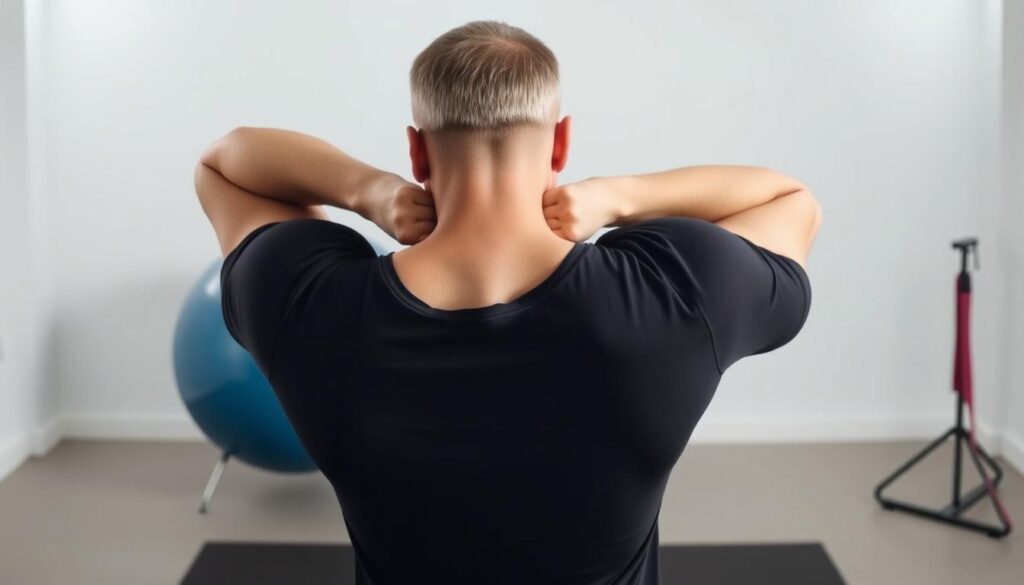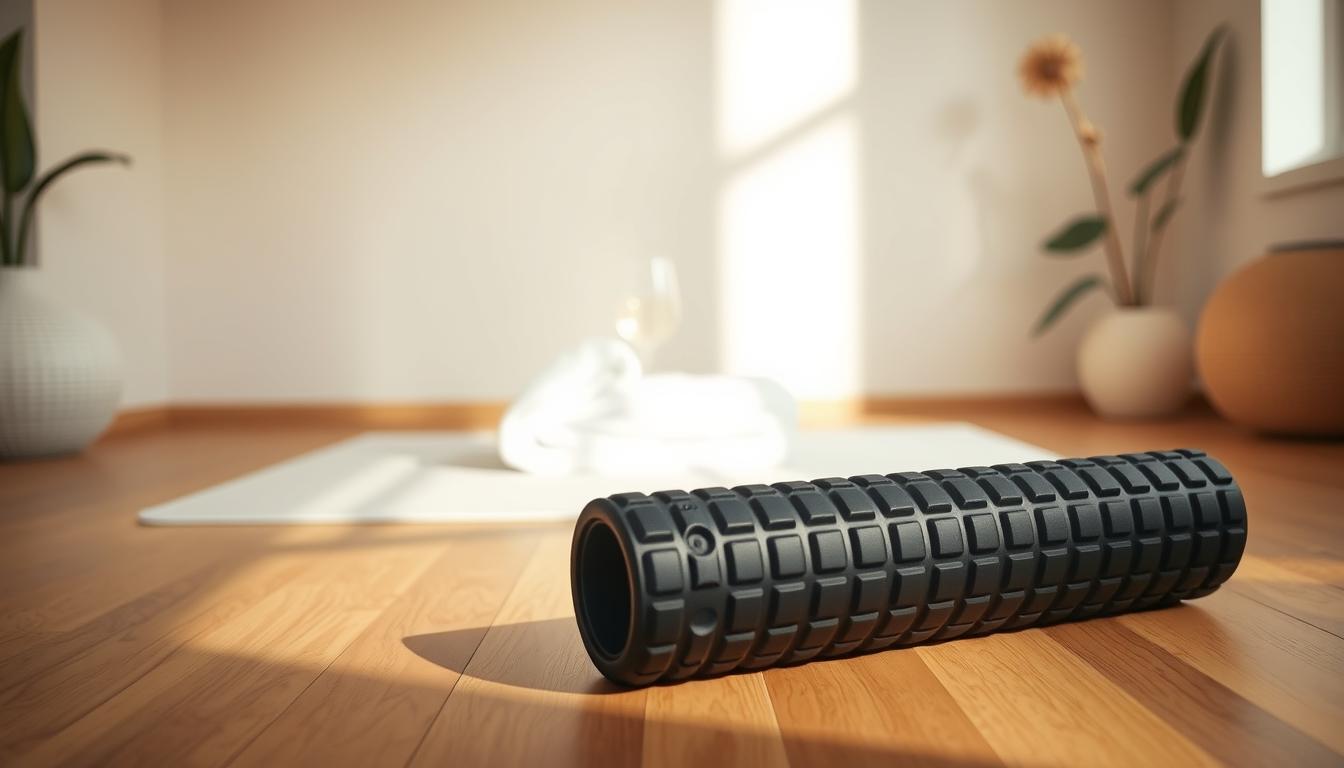In our digital world, tech neck is a growing pain for many. It comes from too much time on smartphones and computers. This leads to a stiff, painful neck, pushing people to look for ways to ease the pain. We’ll dive into some great stretching techniques to ease this discomfort and better your posture. Adding these stretches to your day can help fight the effects of tech neck.
Understanding Tech Neck
More people are using digital devices all the time, leading to a condition called tech neck. It means discomfort in the neck from using phones, tablets, and computers a lot. Because we often look down at our devices, it strains our necks. Understanding tech neck is essential for those who feel its effects.
What is Tech Neck?
Tech neck is pain from looking down at our electronic devices too much. The wrong way we hold our necks can cause a lot of discomfort and tension. This can mess with our daily lives and how we feel overall.
Symptoms of Tech Neck
- Pain and stiffness in the neck
- Headaches originating from the neck
- Discomfort between the shoulder blades
- Reduced mobility of the neck
- Tension in surrounding muscles
Causes of Tech Neck
The main reason we get tech neck is by tilting our heads down to look at screens. Holding our heads this way puts extra pressure on our neck. Here are some other things that make tech neck worse:
- Poor ergonomics in workspaces
- Prolonged hours spent on devices
- Lack of regular physical activity
Impact of Digital Devices on Neck Health
More and more, we rely on our smartphones and digital gadgets. This habit is causing neck problems for many. How we use these devices is key to avoiding smartphone pain. It’s important to know what causes this pain to prevent and ease it.
How Smartphone Usage Contributes to Pain
Staring at our smartphones often makes us tilt our heads. This puts too much pressure on our necks. Such a posture can pull on the neck with the force of up to 50 pounds. This stress increases pain and can lead to long-term neck problems. Being aware of how we use our phones is vital for neck health.
The Role of Poor Posture in Tech Neck
Poor posture makes neck problems from digital devices even worse. Slouching or not supporting our necks can add to the strain. This bad alignment hurts and can damage our necks over time. By sitting straight and using devices the right way, we can avoid these issues.
Stretching Techniques to Avoid Tech Neck
To fight tech neck well, add different stretching moves to your day. Doing neck stretches regularly helps ease stiffness and boosts flexibility. These stretches offer quick relief and act as a way to keep your neck healthy over time.
Here are some great stretches to try:
- Gentle neck tilts to the side can loosen up tension.
- Chin tucks help keep the spine straight and neck muscles active.
- Shoulder rolls work to decrease shoulder tightness and tension.
Adding these neck stretches into your daily routine can really help avoid tech neck. Making stretching a regular habit leads to a healthier neck. It also cuts down on discomfort caused by looking at screens too much.
Ergonomic Workstation Setup
Setting up the right workstation is key to keeping your neck healthy. With our lives focused around technology, an ergonomic setup lessens pain and stops long-term neck problems. You should pay attention to the height of your screen and picking a good office chair.
Importance of Screen Height
The height of your screen should be at your eye level to avoid neck pain. When your screen is too low, you might bend your head down. This bad posture can hurt your neck. To get your screen at the correct height, you can:
- Use monitor stands or risers.
- Get an adjustable desk.
- Check your workstation setup regularly.
Choosing the Right Office Chair
Finding the right office chair matters a lot for your neck health too. A good chair helps you sit properly and eases neck and back stress. When choosing a chair, look for these features:
- It should let you change its height.
- It should support your lower back.
- It should have armrests to help your shoulders relax.
Daily Habits to Combat Tech Neck
Adding good work habits for your neck can really help stop tech neck. A few small changes in what you do every day can make you feel better. Taking breaks often and switching between sitting and standing are great ways to do this.
Frequency of Breaks During Work Hours
It’s important to take breaks every 30 to 60 minutes for your neck’s health. Staring down at screens for too long can make your muscles tight and tired. Just a short break to stretch or walk around can help a lot.
Alternating Between Sitting and Standing
Changing from sitting to standing during your day helps your neck stay healthy. Standing helps keep your body lined up right and stops stiffness. This switch not only helps you feel better but also helps you work better and stay comfy when working a long time.
Strengthening Exercises for Neck and Upper Back
Adding strength exercises for your neck can make your upper back stronger. This can help with better posture and lessen discomfort. Try chin tucks and shoulder blade squeezes to get str
Exercises for Better Neck Support
Chin tucks help you keep a better neck position. To do one, sit or stand tall and pull your chin back to your neck. Make sure your head and spine are in a straight line. Keep this up for a few seconds, then relax. Doing this often throughout the day will make your neck muscles stronger.
Benefits of Shoulder Blade Squeezes
Shoulder blade squeezes are also good for your neck. To do them, keep your arms at your sides. Then, squeeze your shoulder blades together without tensing your arms. Hold this for about five seconds, then let go. This exercise strengthens your upper back. It also helps your neck and improves how you stand.

Stretching Exercises for Neck Relief
Add stretching exercises to your daily plan to ease neck pain from tech neck. These exercises help loosen tight muscles, make your posture better, and improve neck health. Try these techniques to reduce tension and feel better.
Chin Tucks for Alignment
Chin tucks can really help with your neck’s alignment. You just need to gently pull your chin back towards your throat. Doing this often can align your head and spine, reducing bad posture effects from too much screen time.
Neck Rolls to Loosen Tight Muscles
Neck rolls are great for easing tight muscles. Gently roll your head around, stretching those neck muscles. This makes you more flexible and helps with stiffness from staring at screens.
Shoulder Stretches to Counteract Hunching
Shoulder stretches help fight the slouch from tech neck. Lift your shoulders up to your ears, then roll them back. This improves movement and lessens pain. It’s key for keeping your shoulders and neck happy.
Yoga Poses for Tech Neck Relief
Yoga can really help with tech neck pain. It offers both physical and mental relief. Here are three yoga poses that can ease neck tension and help you relax.
Child’s Pose to Release Tightness
The child’s pose gently stretches your back and neck. It helps your body unwind and opens your shoulders. Doing this pose can ease stress and bring peace.
Cat-Cow Pose for Spinal Mobility
This pose makes your spine more flexible. Moving between cat and cow shapes helps fix posture and ease neck and back stiffness. It also boosts blood flow and aligns your neck better during yoga.
Thread the Needle for Neck Stretches
Trying this pose can focus on your neck and upper back. While on your back, stretching one arm through can deepen the stretch. It eases neck tension and enhances mobility too.
Heat and Cold Therapy Techniques
When you have tech neck pain, using heat and cold therapy helps a lot. These treatments do different things but work well together to speed up healing.
Using Heat to Relax Muscles
Heat therapy helps relax your neck muscles and reduce stiffness. Using a heating pad or warm towel increases blood flow. This helps sore spots feel better faster. It’s good to use heat for 15 to 20 minutes for the best effect.
Cold Packs for Reducing Inflammation
On the other hand, cold packs are great for lowering inflammation and easing sharp pain from neck strains. Putting ice in a cloth or using a cold pack can reduce swelling and pain. Use cold therapy right after activities that cause neck pain, for 10 to 15 minutes. Using both heat and cold therapy gives a well-rounded way to deal with tech neck.
When to Seek Professional Help
Tech neck can really stick around, making it important to know when to get help. If your symptoms are too much or making daily life hard, it’s time to see a pro. Learning about treatments like physical therapy and chiropractic care can help you manage your health better.
Understanding Physical Therapy Benefits
Seeing a physical therapist means getting a plan made just for you. They look at how you stand and find muscle issues causing you pain. Your plan could have exercises to make weak muscles stronger, boost flexibility, and better your posture.
Chiropractic Treatments for Long-Term Relief
Chiropractic care works well with physical therapy to give you lasting relief. Chiropractors adjust your spine with their hands to ease tension. This helps with your current pain and improves your neck health, keeping problems away in the future.
Conclusion
In summary, to ease tech neck pain, you need a mix of stretches, right ergonomics, and healthy habits. Using specific stretches and fixing your workspace can lessen neck pain chances. Making these changes helps now and keeps your neck healthy for the future.
Also, knowing about tech neck and its signs helps you start taking care early. With stretches or the right workspace set-up, you can fight off the discomfort. These steps help you handle tech demands without hurting your neck.



